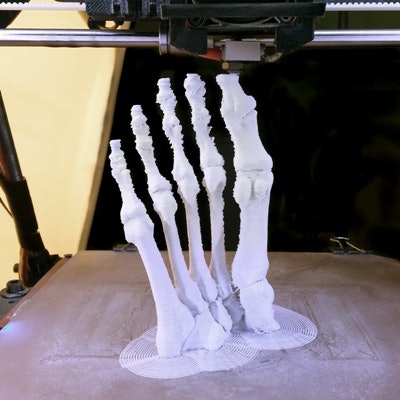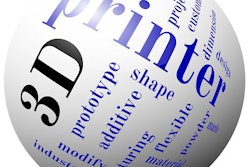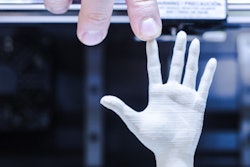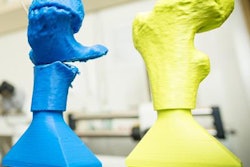
Many of the qualities that make 3D printing such an exciting field are the same ones that create a perilous legal environment for the industry, according to experts at last week's 3DHeals conference. From patent protections to product liability, 3D printing's sparse legal track record and unique manufacturing processes raise issues that lack clear answers.
At a panel session discussing these issues at the San Francisco conference, intellectual property specialist Eric Birkeneder, from the Nixon Peabody law firm, and Colleen Davies, a partner at Reed Smith and a member of the firm's Life Sciences Health Industry Group, talked about law in the emerging field.
Birkeneder said his firm started working in intellectual property in issues related to 3D printing about a year and a half ago, about when Nixon Peabody pulled together a task force to gather knowledge and create strategies for the field.
Protecting intellectual property
"Traditionally, we want to protect the product with patenting and maybe sometimes the process for making it. But for 3D printing, there are so many different products and processes that can be patented, including scans if you're doing medical implants," Birkeneder said.
Is there a unique scanning process, conversion software, or product personalization? Every factor changes the legal environment, he added.
Among the core concepts in 3D printing is the importance of protecting intellectual property on the computer-aided design (CAD) file itself and not just the finished product, Birkeneder said. When clients move into additive manufacturing, it's important to look at every stage of the 3D printing process. High-level concepts should be protected at each step of the way. Intellectual property protections can be designed to automatically protect the intellectual property.
The need for protection applies to 3D printing entrepreneurs and also to third-party players, who often have major roles such as in creating the CAD software or printing the finished product. It's important to ensure that the producers of the intellectual property have adequate safeguards to retain those rights whenever third-party producers work on files, Birkeneder said, to protect it even if an employee or third-party provider walks off with a design file.
For those engaged in additive manufacturing, the use of digital rights management software, which has worked very well in the music industry, is an important practical tool for protecting intellectual property at each stage, he said.
"Once people start moving into printing and start manufacturing in a big way, there will be industrial espionage," Birkeneder said. "So one of the key things is protecting that file in a variety of ways through intellectual patents, copyrights, and trade secrets."
When things go wrong
On the other side of the legal equation are issues of liability and assessing the liability landscape of companies engaged in 3D design and printing, said Reed Smith's Davies, who spends time with companies reviewing the broad range of issues in which problems could crop up.
"One thing that has struck me in our work is that anytime you take innovation and disruption you're going to have risk," she said. "There is innovation and there is disruption -- and what we've found is that there are no traditional legal principles that can be applied to 3D printing."
With an orthopedic implant, there is a finished product, and traditional legal principles apply, Davies said.
"But with 3D printing we've got the computer-aided design, we've got maybe a replacement product along the way, and we've got materials that may not have been tested according to traditional principles -- so everything's upside down. And in this upside-down landscape, I've had trouble getting my mind around the fact that the user is the consumer. The manufacturer is the consumer," she said.
And anyone can upload a design to a third-party 3D printing firm -- whether it's a toy or a medical device.
Liability issues tear up the mold
Traditional legal principles beginning with liability were developed when manufacturing moved away from the realm of artisans and into mass production, Davies said. With mass production, the producer assumes responsibility for making a quality product, but this concept doesn't apply to 3D printing, she said. Whether it's point-to-point manufacturing or dentists producing 3D-printed products in their office, 3D printing is not a traditional commercial setting. Is the printer the manufacturer, is it the printing device, or neither?
For physicians and hospitals, one legal principle that can protect the company from liability under the application of traditional liability standards is the concept of the "learned intermediary doctrine," under which the sole product responsibility lies with the service provider, such as the doctor who implants a 3D-printed device, to consider the risks as a learned individual, and then communicate them to the patient.
This concept was upheld during the only known 3D printing liability case, Buckley v. Align Technology, filed in the U.S. District Court for the Northern District of California, according to Davies. The plaintiff brought an action against the defendant, a manufacturer of 3D digital products intended to treat the misalignment of teeth, alleging that the manufacturer misrepresented the product's performance. The court granted a motion to dismiss the case, concluding a lack of demonstrated fraudulent claims.
What's more, the court held that to the extent the manufacturer had failed to warn the patient of dangerous side effects, the claim was barred by the aforementioned learned intermediary doctrine. Under it, any duty to warn by a manufacturer is borne by the medical professional -- in this case, a product prescribed by the dentist.
Whether this theory will hold up in multiple courts in the coming era of high-volume 3D printing and broad use of the technology is anyone's guess, Davies said. And it's incumbent on the seller or provider of 3D-printed devices to assess the legal landscape and look for areas of potential liability wherever it might arise -- because that's exactly what a plaintiff's lawyer will do in the case of harm.
"Somebody would try to argue strict liability, while we [as defense attorneys] would say it doesn't apply," Davies said. "The physician would say, 'I didn't do it -- it was the implant or the bone itself.' "
Similarly, were the printing materials, the designs, and the printers appropriate for the intended application? Maybe a warning was issued on one of these, or perhaps surgical training was inadequate, she said.
In any case, healthcare providers can count on the panoply of legal theories being tried going forward, Davies said. At this point, guidance from the U.S. Food and Drug Administration is limited to technical specifications for 3D printing that do not specifically address patients or medical procedures involving 3D-printed products.
In Europe now, she added, efforts are underway to change the law for technology companies concerned about the bounds of liability to ensure that products that are changed after they are manufactured won't produce liability for the manufacturer.



















